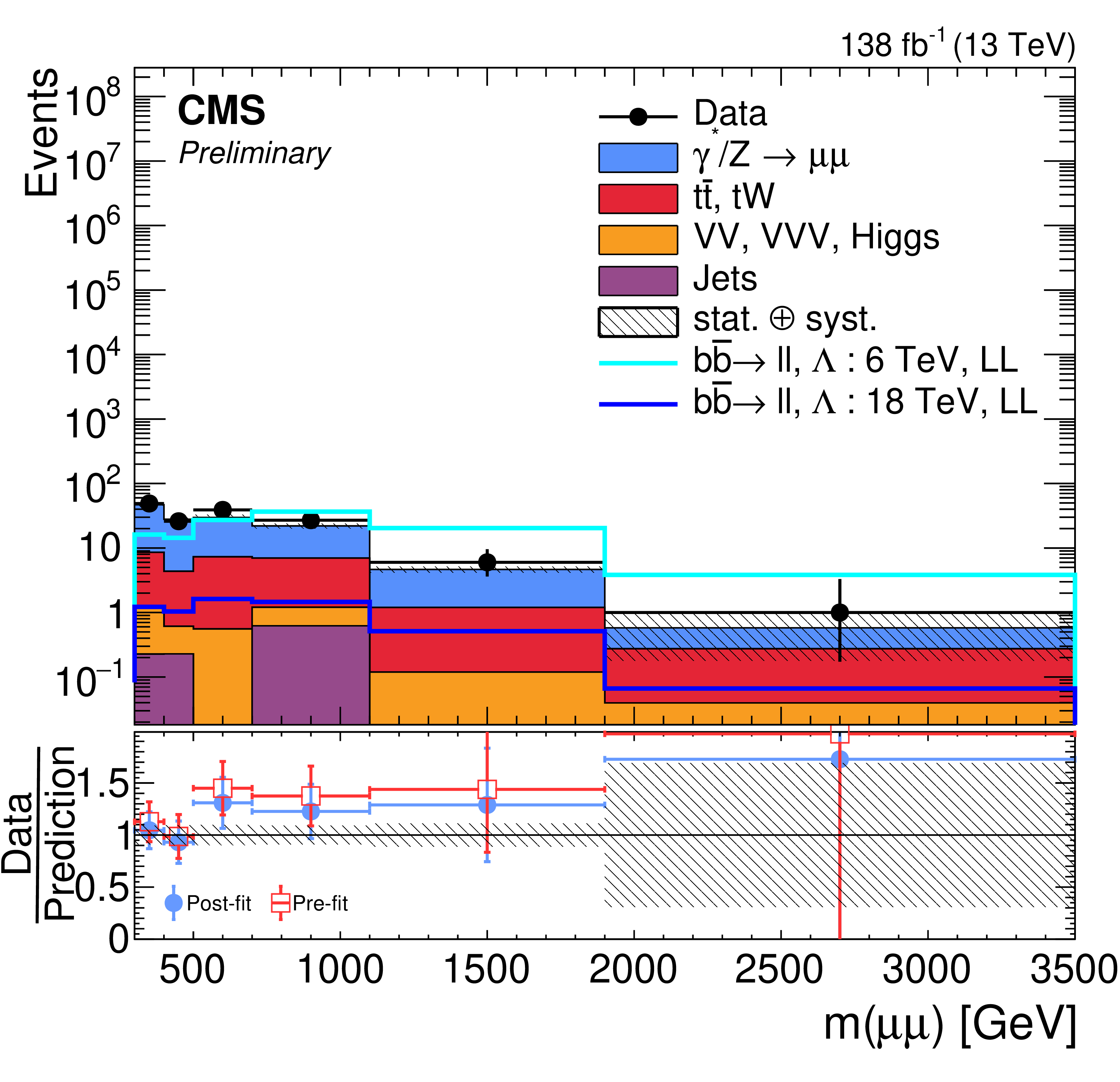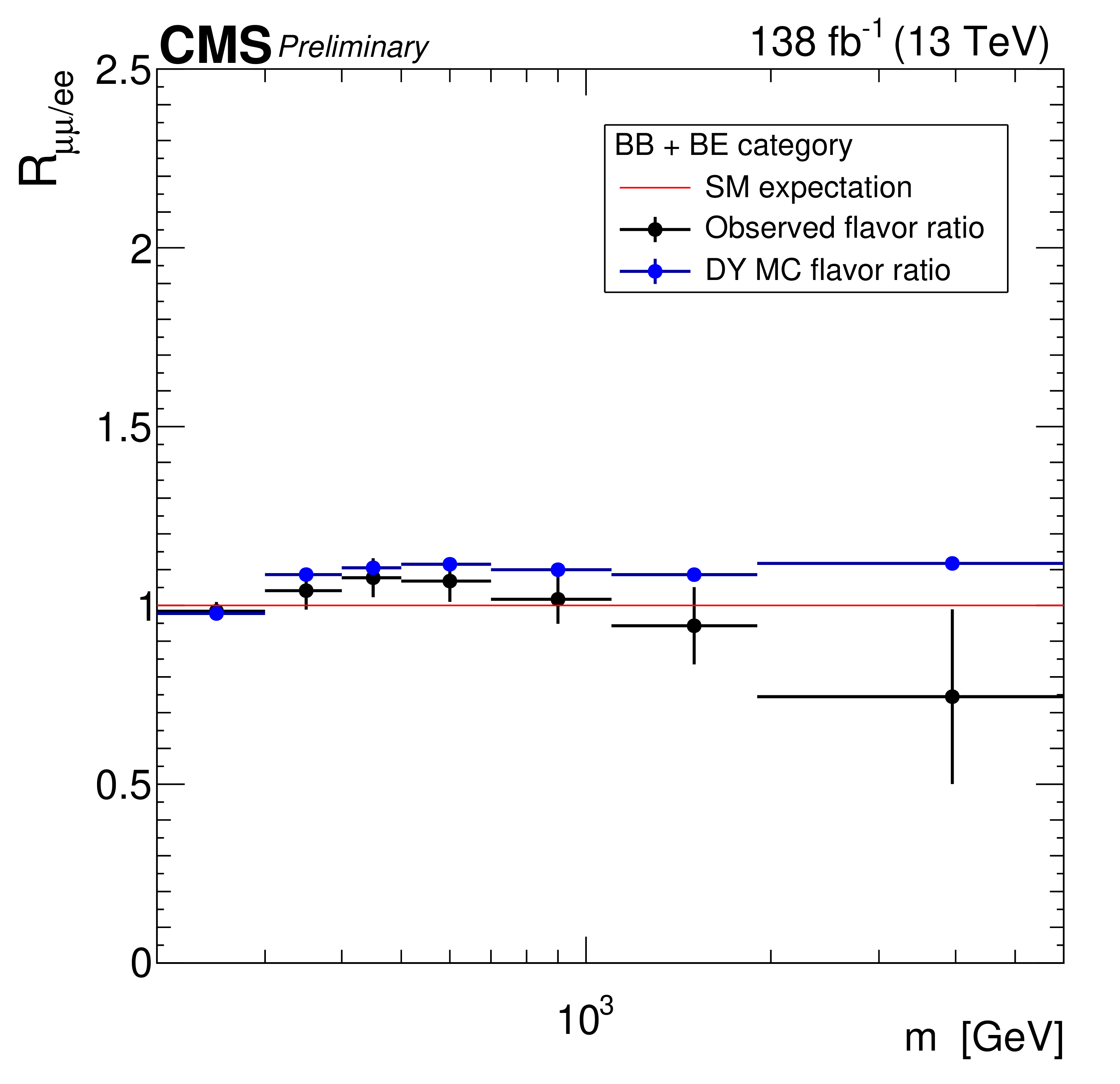
A primary goal of the Large Hadron Collider (LHC) is to hunt for evidence of beyond the Standard Model (BSM) dynamics through deviations from the Standard Model (SM) predictions. If the mass of BSM particles exceeds the energy accessible in LHC collisions, they cannot be produced directly. However, they can indirectly modify the properties of SM particles and interactions. A powerful framework to parametrize the indirect effects of BSM in a model-independent manner is provided by the effective field theory (EFT) framework. Notably, some of the EFT-induced deviations from SM predictions grow with the energy of the collisions, enhancing the sensitivity of EFT searches in the tails of energy/mass distributions.
We have focused on the new physics interactions between two heavy quarks (bottom and strange quarks) and two leptons (electrons and muons). These two-quark-two-lepton EFT interactions predict non-universal coupling of the new physics to the fermions and could potentially explain the observed anomalies in some of the B-meson decays observed by the LHCb, BaBar, and Belle experiments. To hunt for the effects of these two-quark-two-lepton EFT interactions, we analyzed events collected during the 2016–2018 period, selecting those with an electron or a muon pair in association with 0, 1, or 2 bottom quarks, as represented in Fig. 1. This selection allows us to specifically target the signals referred to as bbll and bsll, as represented in Fig. 1.


Figure1: Representative “Feynman” diagrams for the production of dileptons in association with 0, 1, and 2 b-jets via EFT interactions at the LHC.
The analysis methods were developed and validated using samples of simulated events. Detector performance for electron and muon reconstruction and identification was validated using data events with a Z boson decaying into a pair of leptons. After selecting events with a lepton pair and bottom quarks, the most important Standard Model background is the pair production of top quarks. “We used a machine learning approach to reject top quark pair events as much as possible while retaining a good fraction of signal events. This increases sensitivity to new physics and enhances the potential for discovery”, says Amandeep Kaur, who is a postdoctoral researcher at Purdue University and co-leading the effort alongside Reza Goldouzian from the University of Notre Dame and Jan-Frederik Schulte from Purdue University. Then, we validated the top pair production process by selecting events with an electron-muon pair. We carefully considered all relevant uncertainties associated with the SM prediction in the dilepton mass spectra to identify any possible deviations in the data (Fig. 2). The blue and teal lines show an example of the EFT signal that we search for on top of the SM background.

Figure 2: Number of events in bins reflecting the invariant mass of the dimuon system. The blue and teal lines represent the EFT signal while the histograms show the SM processes.
After careful scrutiny of the data, we did not find any statistically significant deviation from the SM prediction. Therefore, we conclude that the energy scale of new physics must be higher than a certain value, specifically above 7-9 TeV for the bbll signal and 2.4 TeV for the bsll signal. This analysis provides the most stringent results obtained from LHC data to date. Additionally, we tested if the fundamental interactions are blind to the generation to which a lepton belongs by measuring its rate of decay into a muon pair versus its decay into an electron pair. According to the SM, these decay rates should be equal, a concept known as lepton flavor universality. The models beyond the Standard Model predict the non-universal coupling to the fermions, which would violate the lepton flavor universality. We tested the lepton flavor universality by taking the ratio of muon pair to electron pair events as a function of the dilepton invariant mass. The measured ratio is found to be consistent with the SM expectation, as seen in Fig. 3.
These results affirm that the Standard Model continues to hold strong, with lepton flavor universality remaining intact for now. Ongoing and future studies with larger datasets and enhanced methodologies may offer further constraints and potentially reveal new physics beyond the Standard Model.

Figure 3: Ratio of the probability of dilepton production in the dimuon and dielectron channels as a function of dilepton mass in 0b final state.
Written by: Amandeep Kaur, for the CMS Collaboration
Edited by: Muhammad Ansar Iqbal
Read more about these results:
-
CMS Physics Analysis Summary (EXO-23-010): "Search for nonresonant new physics in high-mass dilepton events in association with b-tagged jets"
-
@CMSExperiment on social media: Bluesky - Facebook - Instagram - LinkedIn - TikTok - Twitter/X - YouTube

